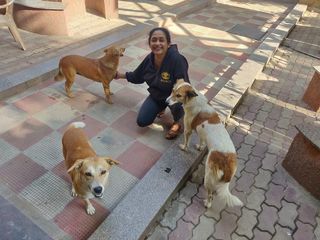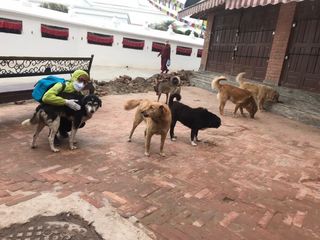Anxiety
Changing Behavior of India's Street Dogs During Lockdown
India's government has declared feeding "streeties" to be an essential service.
Posted April 15, 2020 Reviewed by Kaja Perina

I'm extremely pleased to offer this very valuable "on the ground" guest essay by Sindhoor Pangal, Principal & Director at BHARC, Bangalore, India. It is a goldmine of unique and much-needed information about free-ranging dogs about whom we know very little that can be applied to the estimated 700 million or so dogs who live similar lifestyles around the world. It also covers the nature of dog-human relationships in times of need and is an excellent introduction to what life for dogs will be like as and when humans disappear.1
"The government of India has declared feeding of streeties as an essential service and political leaders are appealing the people to step up to their responsibility of taking care of these animals.
"Feeding hundreds of dogs each day is not easy, and the fact that these people do it every day, day after day, and not only do they feed, but also take care of their vaccines, neutering, deworming, medical interventions and fostering when required is such a mammoth task. They are bit of superheroes in the animal care world."
–Sindhoor Pangal, Principal & Director at BHARC, Bangalore, India
The behaviour of streeties is changing during the COVID-19 lockdown. Streeties rely very heavily on humans for food, both coming from feeders as well as waste from eateries and garbage. With most eateries closed and humans not getting out, it is disorienting streeties as well as driving them to starvation.
But during this grim time, streetie feeders are a ray of hope. The government of India has declared feeding of streeties as an essential service and political leaders are appealing the people to step up to their responsibility of taking care of these animals. But the dogs still need to get used to this new situation, and this is an account of Bismi Anil, one of the most dedicated streetie feeders of Bangalore.2
Street dog feeding experiences during the first two weeks of lockdown
Days 1, 2, and 3 were mostly trailing the sleeping Hachikos in front of hotels/carts/shops waiting for their humans to come and feed them. We met several dogs who were hungry but were surprised to see their food coming from somewhere else. Most quietly ate and went back to their places. Some refused to touch, some searched for their families humans, some couldn’t believe all this is happening.

Days 4, 5, and 6 started bringing out the dogs who usually have specific areas to forage. With the eateries closed and most garbage dried or cleared out, they suddenly found the food sources missing. There was panic, suspicion, and distrust. Most gobbled up the food quickly and wanted more to fill their stomach as much as possible. The menu didn’t matter anymore.
Days 6, 7, and 8: We could hear more and more dogs barking everywhere. It was literally like calling out for food. They could smell the food, and if not given, they barked and called out for food. Panic was evident. Fights were rampant. Everyone wanted to eat all they could, not allowing anyone else to eat. Those who get fed from day 1 were calmer and behaving well, knowing they got something to curb hunger.
Days 9 and 10: We saw most of the home dogs coming out. Those were dogs who were on the streets but attached themselves to particular dwellings and were living happily off the scraps which people used to put out. They had no clue why they were not finding food. They came out in packs, searching and fighting. We saw many that were frozen in fear but ready to risk the bite for a bit of food. It was one of the days when we had lots of extra food as well. They gulped and gulped, drank water, soup, ate dry food. Wherever we passed by but didn’t stop, they chased non-stop, stopped the car, and gobbled up in seconds. It was an eating frenzy, as these dogs were never been subjected to such a situation. Once eaten, they quickly disappeared.

Day 11 onwards: Dogs had become smarter. They didn’t differentiate between kibble or fresh food. If a pack was eating, the frail ones stood far away and subtly called out for food. The ones locked up in tech parks found ways to jump out. The risk of getting injured was big and everyone was getting something to eat, so fights reduced. Last Sunday was peaceful; more and more people came out and fed many dogs. From kibble to veg biryani to chicken biryani fresh-cooked food, a variety of food had been provided to the dogs. Fifty to sixty percent of the usual ones wanted only petting. Those who came to eat also ate less; most looked content.
While there was no food available on day 1-2, it was heartwarming to see people left out whatever they could, along with water, as lockdown progressed. The big tech parks have kept multiple containers with water. Security guards ate half of their food and gave the other half happily to the animals. Feeding stabilised, and despite all fears, more feeders have come out too to take care of the animals.
But all through this, one thing was very clear. The dogs missed their humans and the love they used to get. They tried to cling on to the locations where any human was available. They kept asking, where are their people and would they return? Most humans we found in many spots were thankfully accommodating, reducing the emotional stress on the streeties.
Every night, we come back dead tired but our hearts filled with joy. We also connected to some dogs that were feeding a long time back but had weaned off as other food sources were identified for them and had a happy reunion.
The downside is that our expenses have skyrocketed. The number of dogs stands somewhere between 350-400. We have received contributions from a lot of friends and our communities but we still need a lot of support to sustain this during the lockdown period.
References
Notes:
1) The timing for this piece couldn't have been better, as I was in the process of preparing an essay on this very topic because people were asking me about what was happening with dogs globally in these very challenging times–individuals other than "western homed dogs with whom people are most familiar"–as Pablo (via email) put it. In this vein, Ms. Pangal's piece also calls attention to the fact that many people have a highly skewed view of who dogs are and how they actually live and that we need to be very careful when writing about "dogs" because there is no universal "the dog." Relatively few dogs actually live as homed dogs and their behavior varies greatly. Significant individual differences in behavior also characterize hundreds of million free-ranging dogs living all over the world and we must give them all the very best lives possible. Along these lines, Australian biologist Euan Ritchie and his colleagues stress that people need to be clear about what they mean by "a dog."
Most people are shocked when they learn that it's estimated that around 75-85% of the 1 billion or so dogs in the world live pretty much on their own or totally on their own, because the dogs with whom many people are familiar are "homed" dogs. A dog can be somewhat homed and still be pretty much on their own (free-ranging), it's very difficult to get accurate numbers, and they surely vary regionally. I look forward to writing more on comparisons among free-ranging dogs living globally, because it's not always clear how behavior and personalities might vary among dogs living different lifestyles. Research on the personalities of free-ranging dogs is rare, which makes the studies of street dogs in India, Bali, Italy, and elsewhere very important. Please say tuned for more on these sorts of research projects. It's also well known that homed dogs often live stressful lives that can influence their personalities (for more information on this and other topics also see).
2) Bismi Anil is an IT professional turned animal welfare activist. As result of her interactions with hundreds of pets and closely studying their dietary habits, she has ended up establishing Duma's Bakes n Meals, which not only provides sells a special meal for streeties, but also provides freshly cooked meals and goodies for pet dogs.
For further discussion of what life might be like for dogs as and when humans disappear see these references and links therein. Jessica Pierce and I are completing a book on this fascinating topic.
Angrily, Mary. Dogs in Gilded Cages: Surviving, but Not Thriving.
Bekoff, Marc. How Will Dogs Reshape Nature Without Humans to Control Them?
_____. As Dogs Go Wild in a World Without Us, How Might They Cope?
_____. Puppy Mills, Pandemics, Disaster Preparedness, and Decency.
_____. "I'm a Mess About My Dogs and Coronavirus—How Will They Do?"
_____. Canine Confidential: Why Dogs Do What They Do. Chicago, University of Chicago Press, 2018.
_____. Personality Traits of Companion and Free-Ranging Bali Dogs.
_____ and Jessica Pierce. Unleashing Your Dog: A Field Guide to Giving Your Canine Companion the Best Life Possible. New World Library, Novato, California, 2019.
Coren, Stanley. Are City Dogs More Anxious Than Country Dogs?
Ojha, Anup and Tsering Ngodup Lama. It’s not just humans suffering under the lockdown—dogs are, too. The Kathmandu Post, April 1, 2020. "As butchers, restaurants and shops around Kathmandu have all virtually closed, approximately 26,000 street dogs around the Capital are relying on people like Dekey to keep them fed for as long as the Covid-19 lockdown persists. On Tuesday, Dekey, along with a Street Dog Care staff member, fed and watered approximately 90 dogs, she said."
Ritchie, Euan et al. “Dogs as predators and trophic regulators,” in Matthew Gompper. ed. Free-Ranging Dogs and Wildlife Conservation, New work, Oxford University Press, pp. 55-68, 2014.




